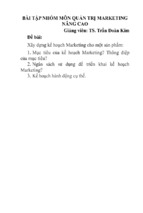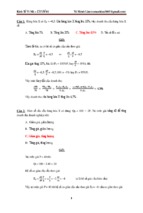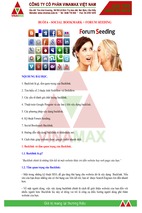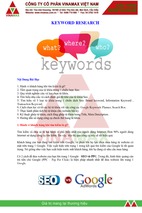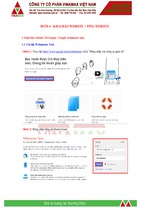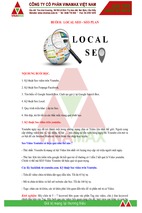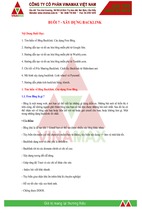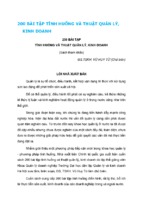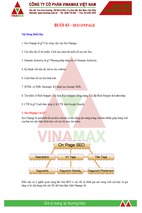Nonprofit
Bookkeeping & Accounting
FOR
DUMmIES
‰
by Sharon Farris
President of Farris Accounting &
Consulting Training Services (FACT$)
www.ebook3000.com
Nonprofit Bookkeeping & Accounting For Dummies®
Published by
Wiley Publishing, Inc.
111 River St.
Hoboken, NJ 07030-5774
www.wiley.com
Copyright © 2009 by Wiley Publishing, Inc., Indianapolis, Indiana
Published by Wiley Publishing, Inc., Indianapolis, Indiana
Published simultaneously in Canada
No part of this publication may be reproduced, stored in a retrieval system or transmitted in any form or
by any means, electronic, mechanical, photocopying, recording, scanning or otherwise, except as permitted under Sections 107 or 108 of the 1976 United States Copyright Act, without either the prior written
permission of the Publisher, or authorization through payment of the appropriate per-copy fee to the
Copyright Clearance Center, 222 Rosewood Drive, Danvers, MA 01923, (978) 750-8400, fax (978) 646-8600.
Requests to the Publisher for permission should be addressed to the Permissions Department, John Wiley
& Sons, Inc., 111 River Street, Hoboken, NJ 07030, (201) 748-6011, fax (201) 748-6008, or online at http://
www.wiley.com/go/permissions.
Trademarks: Wiley, the Wiley Publishing logo, For Dummies, the Dummies Man logo, A Reference for the
Rest of Us!, The Dummies Way, Dummies Daily, The Fun and Easy Way, Dummies.com, Making Everything
Easier, and related trade dress are trademarks or registered trademarks of John Wiley & Sons, Inc. and/
or its affiliates in the United States and other countries, and may not be used without written permission.
All other trademarks are the property of their respective owners. Wiley Publishing, Inc., is not associated
with any product or vendor mentioned in this book.
LIMIT OF LIABILITY/DISCLAIMER OF WARRANTY: THE PUBLISHER AND THE AUTHOR MAKE NO
REPRESENTATIONS OR WARRANTIES WITH RESPECT TO THE ACCURACY OR COMPLETENESS OF
THE CONTENTS OF THIS WORK AND SPECIFICALLY DISCLAIM ALL WARRANTIES, INCLUDING WITHOUT LIMITATION WARRANTIES OF FITNESS FOR A PARTICULAR PURPOSE. NO WARRANTY MAY BE
CREATED OR EXTENDED BY SALES OR PROMOTIONAL MATERIALS. THE ADVICE AND STRATEGIES
CONTAINED HEREIN MAY NOT BE SUITABLE FOR EVERY SITUATION. THIS WORK IS SOLD WITH THE
UNDERSTANDING THAT THE PUBLISHER IS NOT ENGAGED IN RENDERING LEGAL, ACCOUNTING, OR
OTHER PROFESSIONAL SERVICES. IF PROFESSIONAL ASSISTANCE IS REQUIRED, THE SERVICES OF
A COMPETENT PROFESSIONAL PERSON SHOULD BE SOUGHT. NEITHER THE PUBLISHER NOR THE
AUTHOR SHALL BE LIABLE FOR DAMAGES ARISING HEREFROM. THE FACT THAT AN ORGANIZATION OR WEBSITE IS REFERRED TO IN THIS WORK AS A CITATION AND/OR A POTENTIAL SOURCE
OF FURTHER INFORMATION DOES NOT MEAN THAT THE AUTHOR OR THE PUBLISHER ENDORSES
THE INFORMATION THE ORGANIZATION OR WEBSITE MAY PROVIDE OR RECOMMENDATIONS IT
MAY MAKE. FURTHER, READERS SHOULD BE AWARE THAT INTERNET WEBSITES LISTED IN THIS
WORK MAY HAVE CHANGED OR DISAPPEARED BETWEEN WHEN THIS WORK WAS WRITTEN AND
WHEN IT IS READ.
For general information on our other products and services, please contact our Customer Care
Department within the U.S. at 877-762-2974, outside the U.S. at 317-572-3993, or fax 317-572-4002.
For technical support, please visit www.wiley.com/techsupport.
Wiley also publishes its books in a variety of electronic formats. Some content that appears in print may
not be available in electronic books.
Library of Congress Control Number: 2009925029
ISBN: 978-0-470-43236-5
Manufactured in the United States of America
10 9 8 7 6 5 4 3 2 1
www.ebook3000.com
Contents at a Glance
Introduction ................................................................ 1
Part I: Accounting and Bookkeeping Nonprofit Style ...... 7
Chapter 1: The Nuts and Bolts of Nonprofit Bookkeeping and Accounting ............... 9
Chapter 2: Starting with Basic Bookkeeping and Accounting.................................... 25
Chapter 3: Introducing Financial Statements ............................................................... 43
Chapter 4: Keeping Good Records: Using a Manual System or Computer
System............................................................................................................................. 59
Part II: Balancing Your Nonprofit Books...................... 73
Chapter 5: Setting up the Chart of Accounts for Nonprofits ...................................... 75
Chapter 6: Recording Transactions and Journal Entries ............................................ 87
Chapter 7: Balancing the Checkbook: Donations and Expenses ............................. 103
Chapter 8: Balancing Cash Flow: Creating an Operating Budget ............................. 121
Chapter 9: Staying in Nonprofit Compliance .............................................................. 137
Part III: Accounting for Nonprofit Situations ............. 151
Chapter 10: Introducing Federal Grants ..................................................................... 153
Chapter 11: Tracking and Accounting for Federal Dollars ....................................... 167
Chapter 12: Getting Ready for the Grant Audit .......................................................... 187
Chapter 13: Accounting for Payroll and Payroll Taxes ............................................. 205
Chapter 14: Doing the Accounting for Tax Form 990 ................................................ 225
Part IV: Wrapping Up the Books ............................... 241
Chapter 15: Analyzing the Statement of Activities .................................................... 243
Chapter 16: Reporting Financial Condition on a Statement of Financial
Position ......................................................................................................................... 253
Chapter 17: Eyeing the Cash Flow Statement ............................................................. 267
Chapter 18: Organizing the Statement of Functional Expense ................................. 277
Chapter 19: Closing the Nonprofit Books ................................................................... 287
Chapter 20: Preparing for an Accounting Audit ......................................................... 301
Part V: The Part of Tens ........................................... 313
Chapter 21: Ten Important Things to Know When Keeping Nonprofit Books ....... 315
Chapter 22: Ten Tips to Keep Your Nonprofit Viable ............................................... 321
Index ...................................................................... 327
www.ebook3000.com
Table of Contents
Introduction ................................................................. 1
About This Book .............................................................................................. 1
Conventions Used in This Book ..................................................................... 2
What You’re Not to Read ................................................................................ 2
Foolish Assumptions ....................................................................................... 3
How This Book Is Organized .......................................................................... 3
Part I: Accounting and Bookkeeping Nonprofit Style ........................ 3
Part II: Balancing Your Nonprofit Books ............................................. 4
Part III: Accounting for Nonprofit Situations ...................................... 4
Part IV: Wrapping Up the Books .......................................................... 4
Part V: The Part of Tens ........................................................................ 4
Icons Used in This Book ................................................................................. 5
Where to Go from Here ................................................................................... 5
Part I: Accounting and Bookkeeping Nonprofit Style ....... 7
Chapter 1: The Nuts and Bolts of Nonprofit
Bookkeeping and Accounting . . . . . . . . . . . . . . . . . . . . . . . . . . . . . . . . . . .9
Getting Started with Your Nonprofit’s Books ............................................ 10
Identifying the difference between
bookkeeping and accounting .......................................................... 10
Picking your accounting method ....................................................... 11
Understanding the basic terms .......................................................... 12
Adhering to GAAP ................................................................................ 15
Keeping a paper trail ........................................................................... 16
Auditing 101: It’s a GAAS! .................................................................... 16
Making Sure Your Books Are Balanced ...................................................... 17
Establishing a chart of accounts ........................................................ 17
Tracking transactions ......................................................................... 17
Developing a budget ............................................................................ 18
Staying within the lines: Compliance ................................................ 18
You’re in the Money: The Lowdown on Federal Grants ........................... 19
Gleaning some grant basics ................................................................ 19
Following the rules .............................................................................. 20
Going through a grant audit ............................................................... 20
Paying Uncle Sam: Employee Payroll Taxes............................................... 21
Getting a Grasp on Financial Statements.................................................... 21
Figuring Out Where Your Nonprofit Is: Five Important Questions ......... 23
www.ebook3000.com
viii
Nonprofit Bookkeeping & Accounting For Dummies
Chapter 2: Starting with Basic Bookkeeping and Accounting . . . . . .25
Understanding Bookkeeping and Accounting............................................ 25
What’s the difference between bookkeeping and accounting?...... 26
Defining some common financial terms ............................................ 27
Finding the Right People to Manage the Books and Monitor
the Finances ................................................................................................ 29
Considering a bookkeeper or an accountant ................................... 30
Doing it yourself ................................................................................... 31
Opting for a fiscal sponsor or agent .................................................. 31
Outsourcing the job ............................................................................. 32
Hiring an independent auditor ........................................................... 33
Choosing Your Accounting Method ............................................................ 33
Keeping track of the cash ................................................................... 34
Accrual basis of accounting ............................................................... 34
Running Numbers on Your Assets .............................................................. 35
Evaluating assets by original cost or fair market value .................. 35
Grasping depreciation methods ........................................................ 36
Keeping an Eye on Your Assets ................................................................... 39
Protecting your nonprofit’s physical assets .................................... 40
Setting internal controls .................................................................... 40
Chapter 3: Introducing Financial Statements . . . . . . . . . . . . . . . . . . . . .43
The Lowdown on Financial Statements: Why They’re Important ........... 43
Seeing the benefits of tracking the money........................................ 45
Who uses these statements ................................................................ 45
Using Financial Statements to Your Advantage......................................... 47
Assist with grant proposals ................................................................ 47
Allow you to track donations ............................................................. 48
Track nonprofit activities ................................................................... 48
Indicate lawsuits: Contingent liabilities ............................................ 49
Identifying the Financial Statements ........................................................... 49
Reading the statement of activities ................................................... 49
Working with the statement of financial position............................ 52
Developing the cash flow statement ................................................. 52
Grasping the statement of functional expense ................................ 55
Documenting the notes to the financial statements........................ 55
Chapter 4: Keeping Good Records: Using a Manual System
or Computer System. . . . . . . . . . . . . . . . . . . . . . . . . . . . . . . . . . . . . . . . . . .59
Going the Manual or Computer Route? ...................................................... 59
Choosing a Manual System........................................................................... 61
Knowing the pros and cons ................................................................ 61
Eyeing the parts of a manual system................................................. 62
Trying Excel: The Easy Computer Route .................................................... 63
Breaking down the spreadsheet ........................................................ 64
Converting your manual system into a spreadsheet ...................... 65
www.ebook3000.com
Table of Contents
Naming Other Available Software ............................................................... 66
QuickBooks ........................................................................................... 67
Microsoft Office Accounting ............................................................... 67
Peachtree Accounting ......................................................................... 68
Ensuring Your System Is Secure .................................................................. 69
Firewalls and virus scanners .............................................................. 69
User privileges and file sharing .......................................................... 70
Miscellaneous security programs...................................................... 71
Backing Up Your System .............................................................................. 71
Part II: Balancing Your Nonprofit Books ...................... 73
Chapter 5: Setting up the Chart of Accounts for Nonprofits . . . . . . . . .75
Identifying and Naming Your Nonprofit’s Main Types of Accounts ....... 75
Accounting for assets .......................................................................... 77
Labeling liabilities ................................................................................ 78
Net assets: What you’re worth ........................................................... 79
Revenue: What you earn ..................................................................... 80
Nonprofit expense: What you spend ................................................. 82
Net income/increase – decrease in net assets ................................. 85
Coding the Charges: Assigning Numbers to the Accounts....................... 85
Chapter 6: Recording Transactions and Journal Entries . . . . . . . . . . .87
Choosing Your Basis of Accounting ............................................................ 87
Going through the Accounting Process ...................................................... 88
Eyeing the specifics of the process ................................................... 89
Looking at the two sides of an account ............................................ 90
Recording Journal Entries ............................................................................ 91
Step one: Write the transaction date................................................. 92
Step two: Write the account names ................................................... 93
Step three: Write the amount of each debit and credit .................. 93
Step four: Write an explanation or reason for transaction............. 94
Posting to the General Ledger ..................................................................... 94
Reaching the Trial Balance........................................................................... 97
Preparing the trial balance: The how-to ........................................... 97
Understanding which accounts require adjustments ..................... 98
Finding errors ....................................................................................... 99
Correcting errors ............................................................................... 101
Chapter 7: Balancing the Checkbook: Donations and Expenses . . .103
Getting the Lowdown on Your Checkbook Register ............................... 104
Adding and Tracking Nonprofit Donations .............................................. 105
Logging donations in your register ................................................. 106
Raking in the cash, checks, and other donations .......................... 107
Handling and recording the donations ........................................... 110
www.ebook3000.com
ix
x
Nonprofit Bookkeeping & Accounting For Dummies
Subtracting Your Expenses ........................................................................ 111
Making the necessary deductions in your checkbook
register ............................................................................................ 111
Identifying common expenses.......................................................... 112
Relying on direct or automatic bank drafts.................................... 115
Tie It Together: Balancing the Checkbook ............................................... 116
Using the bank statement ................................................................. 116
Entering the information into QuickBooks ..................................... 118
Smoothing Out and Avoiding Errors ......................................................... 118
Finding and addressing errors ......................................................... 118
Considering outstanding checks...................................................... 119
Chapter 8: Balancing Cash Flow: Creating an Operating Budget . . .121
Eyeing the Importance of Having a Budget in the Nonprofit World ..... 121
Getting Off to a Good Start: Preparing to Create an Operating
Budget ....................................................................................................... 123
Setting clear guidelines ..................................................................... 124
Identifying your nonprofit’s objectives ........................................... 125
Eyeing goals ........................................................................................ 126
Staying organized............................................................................... 128
Coming Up with an Operating Budget ...................................................... 130
Walking through the steps to the budget: The how-to ................. 131
Getting your budget approved ......................................................... 134
Reviewing Budget Performance ................................................................. 134
Establishing a budget task group .................................................... 135
Making adjustments .......................................................................... 135
Chapter 9: Staying in Nonprofit Compliance . . . . . . . . . . . . . . . . . . . . .137
Understanding Why Being Compliant Is Important for Your
Nonprofit ................................................................................................... 138
Staying in Compliance: The How-To ......................................................... 138
Register with the proper state authority ........................................ 138
Account for nonprofit activities ....................................................... 139
Hire professional help ....................................................................... 139
Abide by IRS statutes ........................................................................ 140
Following Accounting Standards ............................................................... 140
The fascinating FASB ......................................................................... 141
The world according to GAAP .......................................................... 143
Sorting out the Sarbanes-Oxley Act (SOX) ..................................... 146
Avoiding Activities that Can Call Your Compliance into Question ....... 149
Conflicts of interest ........................................................................... 149
Lobbying or supporting candidates ................................................ 149
Unrelated business income .............................................................. 150
www.ebook3000.com
Table of Contents
Part III: Accounting for Nonprofit Situations .............. 151
Chapter 10: Introducing Federal Grants . . . . . . . . . . . . . . . . . . . . . . . . .153
Grasping Why Federal Grant Money Is Important to Nonprofits .......... 154
The 4-1-1 on Grants: Just the Basics ......................................................... 155
Defining a federal grant ..................................................................... 155
Finding and applying for federal grants for your nonprofit ......... 156
Documenting where the money goes .............................................. 157
Managing Federal Grant Money: The Do’s and Don’ts............................ 159
2 CFR Part 215 for administrative requirements ........................... 160
OMB Circular A-122 for cost principles .......................................... 160
OMB Circular A-133 for government audit requirements ............. 161
Working Through the Details of Your Grant Agreement ........................ 162
Summarizing the grant budget ......................................................... 163
Knowing the due dates for financial status reports ...................... 164
Indicating special conditions ........................................................... 164
Keeping the award/project period in mind .................................... 165
Treatment of program income ......................................................... 165
Figuring your indirect cost rate ....................................................... 165
Federal and nonprofit shares ........................................................... 165
Chapter 11: Tracking and Accounting for Federal Dollars . . . . . . . . .167
Understanding Your Obligation ................................................................. 168
Managing Grant Funds ................................................................................ 169
Maintaining a separate budget for your grant dollars .................. 169
Making changes to your grant .......................................................... 170
Handling the responsibility of subgrantees ................................... 171
Drawing Down Federal Dollars .................................................................. 173
Transferring grant money ................................................................. 174
Tracking the electronic transfer ...................................................... 175
Knowing when to request a drawdown .......................................... 176
Reporting Requirements............................................................................. 176
Financial Standard Form 269 ............................................................ 177
Progress reports ................................................................................ 182
Closing Out a Grant ..................................................................................... 185
Chapter 12: Getting Ready for the Grant Audit . . . . . . . . . . . . . . . . . . .187
Understanding the Purpose of the Grant Audit ....................................... 188
Who Should Undergo an Audit? ................................................................. 189
When You’re Notified: Comprehending the Nitty Gritty of the Audit ... 190
Identifying the Types of Grant Audits ....................................................... 190
The relatively painless desk audit ................................................... 191
Knock, knock: Knowing what to expect during a monitoring
site visit ........................................................................................... 191
www.ebook3000.com
xi
xii
Nonprofit Bookkeeping & Accounting For Dummies
Preparing for the program officer’s perusal of your
procedures ...................................................................................... 192
Inspector general audit: When the situation is really serious ..... 194
Knowing What the Auditor Looks For....................................................... 195
Preparing the books for audit review.............................................. 196
Proving your agency’s existence with organizational
records and documents ................................................................ 197
Tracking all grant expenses .............................................................. 198
Auditing Cash Management ....................................................................... 198
Minimizing cash on hand .................................................................. 199
Segregating duties through internal controls ................................ 199
Receiving the Report of Audit Findings .................................................... 201
Classifying the audit finding ............................................................. 202
Following the corrective action plan............................................... 202
Chapter 13: Accounting for Payroll and Payroll Taxes . . . . . . . . . . . .205
Setting Up Payroll Accounts for Nonprofit Employees........................... 206
Deducting the Right Amount of Taxes ...................................................... 207
Salaries and wages ............................................................................. 208
Overtime and cash advances ........................................................... 209
Calculating Specific FICA Payroll Taxes and Deductions ....................... 210
Paying Quarterly Payroll Taxes with Form 941 and Form 8109............. 212
Completing Form 941 ........................................................................ 213
Filing Form 941 ................................................................................... 215
Completing Form 8109 (Making tax deposits) ................................ 216
Completing End-of-Year Forms .................................................................. 219
Filling out the W-2 .............................................................................. 219
Filling out the W-3 .............................................................................. 220
Where to send the W-2s and W-3s ................................................... 222
Accounting for Contract Employees: Form 1099-MISC ........................... 222
Chapter 14: Doing the Accounting for Tax Form 990 . . . . . . . . . . . . . .225
Choosing the Right Form: Which One Do You Need? ............................. 226
Knowing What Happens If You Don’t File Form 990................................ 227
Understanding the Minimal Requirements: Form 990-N
(e-Postcard) .............................................................................................. 228
Filling Out Form 990-EZ ............................................................................... 229
Filling Out Form 990 .................................................................................... 231
Walking through Form 990................................................................ 231
Submitting Form 990.......................................................................... 233
Completing Form 990-T (Reporting Unrelated Business Income) ......... 234
Handling IRS Form 990 Extensions and Mistakes .................................... 236
Requesting an extension ................................................................... 236
Correcting Form 990 mistakes ......................................................... 236
Keeping in Line with IRS Regulations ........................................................ 238
Reporting nonprofit unrelated business income ........................... 238
Reporting nonprofit contributions .................................................. 239
www.ebook3000.com
Table of Contents
Part IV: Wrapping Up the Books ................................ 241
Chapter 15: Analyzing the Statement of Activities. . . . . . . . . . . . . . . .243
Understanding the True Meaning of the Statement of Activities .......... 244
Revenues ............................................................................................. 246
Expenses ............................................................................................. 247
Gains and losses................................................................................. 247
What this statement doesn’t show .................................................. 248
Evaluating the Data ..................................................................................... 248
Analyzing revenues and expenses ................................................... 249
Determining change in net assets .................................................... 250
Using the statement to make comparisons .................................... 251
Chapter 16: Reporting Financial Condition
on a Statement of Financial Position . . . . . . . . . . . . . . . . . . . . . . . . . . .253
Grasping What the Statement Says about Your Nonprofit..................... 253
Creating and Reading a Statement of Financial Position:
The How-To .............................................................................................. 255
Understanding the statement’s structure ...................................... 255
Classifying assets ............................................................................... 258
Classifying liabilities and net assets ................................................ 260
Evaluating the Numbers ............................................................................. 264
Calculating working capital .............................................................. 265
Calculating a debt-to-equity ratio .................................................... 265
Chapter 17: Eyeing the Cash Flow Statement . . . . . . . . . . . . . . . . . . . .267
Seeing What the Cash Flow Statement Can Tell You about Your
Nonprofit ................................................................................................... 267
Using the statement to see the big picture..................................... 268
Making decisions based on the statement ..................................... 269
Understanding How to Create and Use a Cash Flow Statement ............ 269
Getting the statement started .......................................................... 270
Identifying the parts of the statement............................................. 271
Doing the math ................................................................................... 272
Analyzing Cash Flow Indicators ................................................................. 274
Calculating the operating cash flow ratio ....................................... 275
Determining free cash flow ............................................................... 275
Chapter 18: Organizing the Statement of Functional Expense. . . . . .277
Classifying Functional Expense ................................................................. 277
Keeping track of time ........................................................................ 278
Allocating expenses ........................................................................... 281
Using the Statement of Functional Expense to Calculate Ratios ........... 284
Program spending ratio .................................................................... 285
Fundraising efficiency ratio .............................................................. 285
xiii
xiv
Nonprofit Bookkeeping & Accounting For Dummies
Chapter 19: Closing the Nonprofit Books . . . . . . . . . . . . . . . . . . . . . . . .287
Understanding the Need to Close Your Nonprofit’s Books.................... 288
Adjusting, Closing and Reversing Entries................................................. 289
Adjusting entries: Year-end .............................................................. 290
Closing entries: A 1-2-3 step.............................................................. 293
Reversing entries to close temporary accounts ............................ 295
Completing the Notes to the Financial Statements ................................. 296
Explaining changes in accounting methods ................................... 297
Noting all lawsuits.............................................................................. 299
Including all contingent liabilities.................................................... 299
Noting conditions on assets and liabilities..................................... 300
Putting Last Year Behind You and Looking Forward .............................. 300
Chapter 20: Preparing for an Accounting Audit . . . . . . . . . . . . . . . . . .301
Understanding the Audit Purpose and Need ........................................... 301
Considering the nonprofit constituency ......................................... 302
Knowing who’s involved in the process ......................................... 303
Searching for Accountability: Leaving a Paper Trail............................... 305
Walking through the Audit Process .......................................................... 306
Phase I: Planning and design ............................................................ 306
Phase II: Calculating audit risk ......................................................... 306
Phase III: Analysis .............................................................................. 307
Phase IV: Gathering final evidence and issuing the report........... 307
After the Audit Is Finished: Receiving the Auditor’s Report .................. 308
Eyeing the importance of the opinion ............................................. 308
Identifying the types of auditor opinions you can receive ........... 309
If You Get Audited by the IRS ..................................................................... 311
Part V: The Part of Tens ............................................ 313
Chapter 21: Ten Important Things to Know When Keeping
Nonprofit Books . . . . . . . . . . . . . . . . . . . . . . . . . . . . . . . . . . . . . . . . . . . . .315
Watch Cash Contributions ......................................................................... 315
Keep a Donors List ...................................................................................... 316
Balance Your Nonprofit Checkbook.......................................................... 316
Leave a Paper Trail ...................................................................................... 316
Protect Your Nonprofit from Employee Theft ......................................... 317
Consider Your Constituency ...................................................................... 318
Stay in Compliance ...................................................................................... 318
Track the Truth in the Books ..................................................................... 318
Keep Charities and Politics Separate ........................................................ 319
Get Free Support .......................................................................................... 319
Table of Contents
Chapter 22: Ten Tips to Keep Your Nonprofit Viable . . . . . . . . . . . . . .321
Keeping Your Books Balanced ................................................................... 321
File Paperwork with the IRS ....................................................................... 322
Pay Bills on Time ......................................................................................... 323
Explore New Fundraising Ideas ................................................................. 323
Watch Your Nonprofit’s Bottom Line ....................................................... 323
Analyze, Plan, and Project Future Funding Streams ............................... 324
Get Grant-Writing Training ......................................................................... 324
Get an Independent Audit........................................................................... 325
Get Acquainted with Elected Officials ...................................................... 325
Attend Networking Activities ..................................................................... 326
Index ....................................................................... 327
xv
xvi
Nonprofit Bookkeeping & Accounting For Dummies
Introduction
C
ounting the money in your wallet or purse is an act of accounting. If you
ever make a note of how much you have, you’re even performing a
bookkeeping function. You count things all the time in everyday life without
thinking twice about accounting. For example, you count the plates before
setting the table at home. You count the number of e-mails you receive while
you’re out of the office. Even a gesture such as looking at your watch and
thinking about how much time you have before your next appointment is a
form of accounting.
Bookkeeping and accounting are service activities that involve auditing,
tax services, management advisory services, general accounting, cost
accounting, budgeting, and internal auditing. Even though your organization
is a nonprofit, these services are essential parts of your daily activities.
Without them, your nonprofit can’t survive the long haul.
In the wake of increased accountability, understanding how to track and
account for the everyday activities of your nonprofit is important. Keeping
the books for a nonprofit is exciting. Getting federal grant money to fund your
programs relieves financial stress. Getting a clean bill of health from your
financial audit adds credibility. I devote this book to all nonprofits that add
credibility to the sector by keeping their books in order.
About This Book
Bookkeeping and accounting for an organization involve several fundamental
steps. Beginning with a simple transaction such as a donation and ending
with financial statements, you go through an accounting cycle of 12 months.
The cycle repeats as long as your nonprofit continues to operate. To
help you with the normal day-to-day transactions — as well as any sticky
situations you may find along the way — I wrote this book for the nonprofit
director and manager (as well as the nonprofit bookkeeper and accountant).
Feel free to use this book as a quick reference. It’s designed to help you
with everything you need to know to operate your nonprofit according to
generally accepted accounting principles (GAAP). It covers information
about the steps to file your own payroll taxes and tax information Form 990.
It also explains how to account for almost every situation that may come up
in your nonprofit.
2
Nonprofit Bookkeeping & Accounting For Dummies
This book serves as a tool that you can pick up from time to time during your
accounting cycle to brush up on the following steps:
1. Your nonprofit enters into a transaction with a second party.
2. You or your employee prepares a business document, such as a sales
invoice, that leaves a paper trail.
3. You or your employee records the transaction in the book of first
entry, your journal.
4. You post the transaction to the general ledger.
5. You balance the general ledger and prepare a trial balance. Your trial
balance tests the accuracy of account (debit and credit) balances.
6. You prepare your financial statements.
This book serves as a reference tool, no matter where you are in the
accounting process, by helping you reach your ultimate goal of well-prepared
and accurate financial statements.
Conventions Used in This Book
Throughout this book, I use the following conventions to help you find
your way:
✓ Every time I introduce a new word, I italicize it and then define it.
✓ Boldface text is used to indicate keywords in bulleted lists or to
highlight action parts of numbered steps.
✓ Monofont is used for Web site addresses.
What You’re Not to Read
I understand that you’re a very busy person working in a small- to mediumsized nonprofit. Every day throws different and unique challenges at you.
You won’t hurt my feelings if you don’t read every word I’ve written. So if
you’re strapped for time, feel free to skip the sidebars (the gray boxes). In
sidebars, I include some real-world examples that you can skip — don’t
worry, you won’t miss anything essential to understanding my point.
Introduction
Foolish Assumptions
While writing this book, I made the following assumptions about you, my
dear reader. Some may be more relevant than others.
✓ You’re the executive director of a newly formed, small nonprofit, and
you want to know how to manage your own books.
✓ You direct or manage a midsize nonprofit and want to understand a little
more about how to manage day-to-day operations and take care of your
own books.
✓ You’re interested in keeping the books of a nonprofit organization.
✓ You’re interested in bookkeeping and accounting as a profession.
✓ You’ve been performing the functions in this book, but you’re not sure if
you’ve been doing them right.
✓ You’re thinking about starting your own nonprofit and want to know
how an effective nonprofit keeps track of its bookkeeping and
accounting needs.
Finally, I assume you know that you can read this book over and over again
and discover something new every time. You can refer to this book as a quick
reference whenever you need to know the how-to of managing your financial
records for your organization. I assume this book takes the guesswork out of
bookkeeping and accounting and provides some peace of mind about how
the system is designed and how you can work it to benefit your organization.
After reading this book, I hope you’re confident that you can take care of
most of your bookkeeping and accounting needs yourself. At least, you can
get a better handle on how your accounting cycle functions.
How This Book Is Organized
This book is organized into five parts. You don’t have to read it from cover to
cover; you can dip in for reference at any point that interests you and jump
from part to part if you like. I won’t tell anyone.
Part I: Accounting and Bookkeeping
Nonprofit Style
This part talks about basic bookkeeping and accounting terminology. You
can also find a chapter that helps you understand financial statements.
3
4
Nonprofit Bookkeeping & Accounting For Dummies
And when you’re ready to get your hands dirty, you can read about record
keeping and then decide whether to design your own computer system or
use store-bought software.
Part II: Balancing Your Nonprofit Books
This part covers the nuts and bolts of setting up and balancing your nonprofit books. I cover how to set up a chart of accounts, how to record
transactions in the bookkeeping journal, and how to make entries in and
balance your nonprofit’s checkbook. Balancing your cash flows and planning
your budget are two important aspects discussed in this part. If you’re not
sure how to stay in compliance with federal nonprofit guidelines, follow the
tips suggested here for help.
Part III: Accounting for Nonprofit
Situations
I should have named this part “Documentation 101” because that’s what the
chapters here seem to boil down to. Part III focuses on grants, payroll, and
accounting for Form 990, all of which are extremely important for keeping
your nonprofit up and running. This part covers information about federal
grants management and the grant audit. Everything you need to know about
payroll taxes and filing Form 990 also is summarized here to keep you in good
standing with the IRS and Uncle Sam. All of these tasks come back to staying
organized and keeping a good paper trail.
Part IV: Wrapping Up the Books
Part IV shows you how to create your own financial statements. It also
describes the steps you have to take to close one accounting period and
prepare the books for the next cycle. Finally, in this part, I cover what you
need to do to prepare your books for an audit of your financial statements.
Part V: The Part of Tens
This is the famous For Dummies Part of Tens. You can find out how to keep
your books in good standing and how to stay out of hot water with the
federal government using the helpful tips in this part. After reading these
chapters, you can feel confident that you’re indeed going about your books in
the right way.
Introduction
Icons Used in This Book
For Dummies books use little pictures, called icons, to get your attention in
the margins. Here’s what they mean:
This icon highlights techniques or draws your attention to something
noteworthy.
This icon highlights important information to keep in mind and points out
things you shouldn’t forget.
This icon points out pitfalls and signals red flags of caution.
This icon points out real-life anecdotes from my years of experience and
mistakes.
Where to Go from Here
Like every For Dummies book, each chapter stands alone, so you can jump
from chapter to chapter and read whichever ones pique your interest. Glance
at the table of contents and go to the topic that interests you. You can
read this book in many ways, depending on your needs. If you’re new to the
nonprofit arena, start with Part I. If you’re a veteran, I suggest you brush up
on some info about filing your tax information in Part IV. Make plans to read
the information more than once. You don’t have to remember this stuff; just
pull your book out and use it as a reference as you need it.
This book is organized in an order logical to the accounting process, but you
don’t need to read it from front to back to gain important insight and wisdom
about the tricks of the trade. Feel free to read it cover to cover if you’re just
biting at the bit to uncover everything you can about nonprofit bookkeeping
and accounting.
5
6
Nonprofit Bookkeeping & Accounting For Dummies
Part I
Accounting and
Bookkeeping
Nonprofit Style
- Xem thêm -

